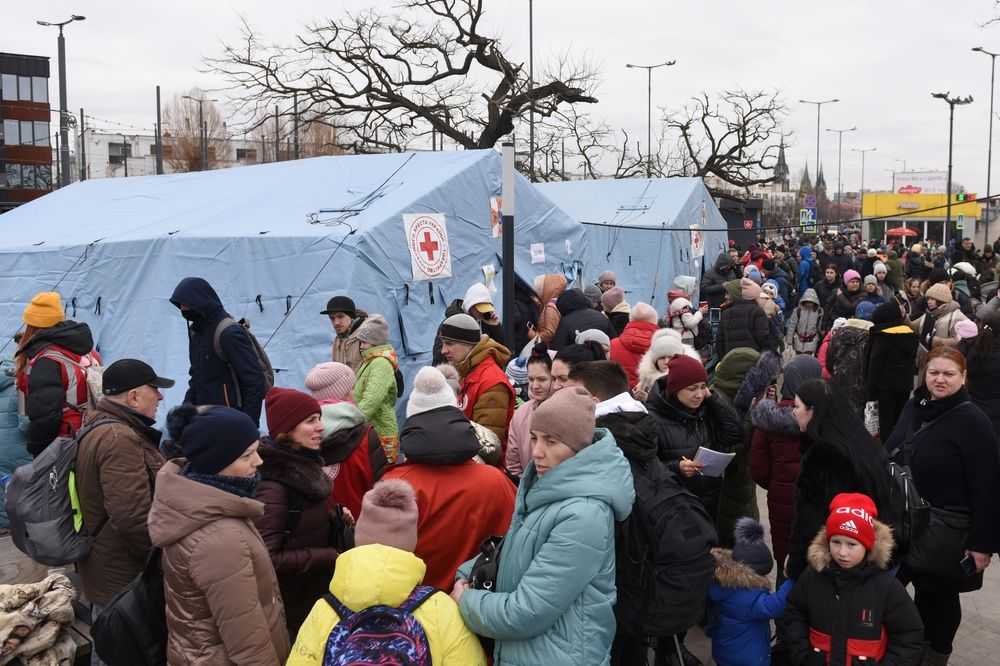Accueil>Villes, société civile et universités, des acteurs de l’accueil des réfugiés devenus incontournables

14.04.2022
Villes, société civile et universités, des acteurs de l’accueil des réfugiés devenus incontournables
Par Thomas Lacroix et Colleen Thouez
La crise ukrainienne a jeté sur les routes de l’exil plus de 4 millions de personnes(1). Environ 10 000 arrivent chaque jour à Berlin. En France, l’administration prévoit l’arrivée de 100 000 réfugiés. A ce jour, 18 000 cartes individuelles et familiales de protection temporaire(2) ont été délivrées, concernant 35 000 personnes au total. A cet afflux, il faut ajouter une hausse probable des demandeurs d’asile en provenance de Russie qui n’auront toutefois pas droit au statut de protection temporaire. Aucun dispositif d’accueil et d’hébergement national n’est dimensionné pour faire face à ce type de situation. A la rigidité juridique s’ajoute la temporalité de l’action administrative, trop lente et inadaptée aux situations d’urgence. Dans ce contexte, les pouvoirs publics n’ont d’autres choix que de s’en remettre aux acteurs locaux, que ceux-ci soient publics (municipalités et préfectures) ou associatifs. Cette place croissante accordée aux acteurs locaux transforme la gouvernance de l’asile. Nous présentons brièvement la montée en puissance de trois d’entre eux : les municipalités, les associations, les universités.
Lille, jumelée avec Kharkiv, a ouvert 250 places d’hébergement et en a identifié 800 autres dans la population locale. La ville de Metz a recueilli 250 ukrainiens le 8 mars. Les initiatives se multiplient partout en France, à Dijon, Lyon ou Nancy, y compris en zone rurale. Pour beaucoup de personnes, la municipalité est l’interlocuteur vers lequel on se tourne spontanément lorsque l’on souhaite apporter son aide ou manifester sa volonté d’accueillir une personne. Avec les préfectures, la municipalité est devenue le relais d’une mobilisation des acteurs locaux sur lesquels les pouvoirs publics souhaiteraient s’appuyer. Les villes françaises ont développé, au fil des années, un savoir-faire en matière d’accueil. L’Association nationale des villes et territoires accueillants a été créée en 2018 par Damien Carême, ancien maire de Grande Synthe, pour développer un modèle d’accueil inconditionnel des migrants. En 2021, lors de la prise de pouvoir des Taliban en Afghanistan, l’ANVITA s’est déclaré en faveur de l’accueil des réfugiés. L’association a très vite été approchée par la Direction interministérielle de de l’accueil et de l’intégration des réfugiés (DIAIR) pour recenser les capacités d’hébergement disponible. En 2022, l’ANVITA a de nouveau été sollicitée pour coordonner l’implication de ses membres, mais les des flux anticipés beaucoup plus importants, et surtout sans aucun apport financier correspondant. L’objectif, pour le gouvernement, est d’élargir ses capacités d’accueil à moindre coût, tandis que les villes et les villages se tournent vers leurs habitants.
L’accueil dépend donc en grande partie de la bonne volonté des individus et de la mobilisation des associations. Celles-ci apportent une dimension personnelle et humaine nécessaire pour l’accueil de personnes parfois traumatisées par leur expérience. Cette infrastructure de l’accueil s’est construite au fil du temps. En 2019 sont mis en place les contrats d’accueil et d’intégration des réfugiés (CTAIR) afin d’assurer une meilleure articulation entre l’action de l’Etat, celle des préfectures et celle des métropoles signataires pour améliorer l’accès aux services. L’État a donc accompagné la mise en place d’une infrastructure locale de l’accueil mais celle-ci a également été construite « par le bas », grâce à la mobilisation des citoyens. Au cours de la dernière décennie, et plus particulièrement depuis la vague des arrivées de réfugiés en provenance du Moyen-Orient en 2015 se sont multipliés les dispositifs d’hébergement chez l’habitant, parfois avec le soutien d’organisations « historiques » : le programme Welcome, soutenu par le Jesuit Relief Service, ou encore le programme J’accueille de la plateforme Singa. Longtemps stigmatisé, voire condamné par les pouvoirs publics (en particulier lors de l’accueil de migrants sans papiers), ce type d’engagement se normalise : les assurances (France assurance) ont décidé d’étendre gratuitement la couverture habitation d’une famille aux personnes qu’elle peut héberger.
Les universités constituent la troisième catégorie d’acteur à avoir pris de l’importance au cours de ces dernières années. Le programme PAUSE, créé en 2017, permet d’intégrer des artistes et des scientifiques en exil dans un cadre universitaire. Le programme bénéficie d’une diversité de financements publics (Etat, Union européenne) mais aussi privés (fondation Michelin, Open Society Foundations), ce qui lui assure une certaine pérennité. Au cours des cinq dernières années, le programme a soutenu l’accueil de 300 chercheurs (principalement des doctorants, souvent accompagnés par leur famille). Ses gestionnaires ont reçu 135 demandes d’accueil rien qu’au cours du mois de mars, un chiffre jamais atteint jusqu’ici. Le programme reçoit en temps normal deux appels à candidatures par an auxquelles doivent répondre des universités volontaires pour obtenir un cofinancement. Au regard de la situation d’urgence, ce mode de fonctionnement a été modifié. Le programme a mis en place un fonds d’urgence de 500 000 euros pour permettre l’accueil de chercheurs ukrainiens pour une durée initiale de trois mois sans besoin de cofinancement. Depuis le 2 mars, une centaine de candidatures sont en cours de traitement, les quatre cinquièmes concernant des femmes. En parallèle, une levée de fonds est en cours auprès d’opérateurs privés afin d’augmenter le budget disponible.
On le voit, la crise ukrainienne a suscité la mise en place d’une infrastructure de l’accueil sans précédent. Cet élan va-t-il s’essouffler ou au contraire marquer durablement l’accueil des réfugiés en France, y compris celui de populations non européennes ?
La situation actuelle offre une tribune inédite à l’ensemble de ces acteurs qui tous revendiquent un accueil inconditionnel des demandeurs d’asile, sans discrimination d’origine. Il existe néanmoins un risque d’une « fatigue » de l’accueil, accélérée par la surcharge portée par les services publics et la pénurie de logement. Dans un contexte de tension croissante, un possible fait divers pourrait rapidement renverser les dispositions de l’opinion publique. C’est ce que l’on a observé au Moyen-Orient (Turquie, Liban), dans les pays qui ont accueilli des réfugiés syriens. Même en cas de résolution rapide du conflit et de retour des exilés ukrainiens dans leur pays, il est fort peu probable que l’actuel élan de solidarité s’étende aux immigrants non européens.
Pour autant, de nombreux indices suggèrent que l’année 2022 marquera un tournant dans la gouvernance de l’accueil. En premier lieu, un regard rétrospectif nous enseigne que la mise en place des infrastructures de l’accueil est un processus incrémental qui s’accélère en temps de crise. Ces crises sont des périodes de prise de conscience, d’acquisition de savoir-faire, de création de structures, de mise en place de procédures, qui, même si elles disparaissent par la suite peuvent être réactivées lors d’une crise suivante. On constate à travers le profil des individus qui choisissent de s’engager que la perception de l’hébergement par l’opinion publique est en train de changer. On le note également au niveau institutionnel tandis que le gouvernement met en place une plateforme permettant aux volontaires de rendre public leur désir d’accueillir. Le dialogue entre pouvoirs publics, associations et municipalités est un signe de l’intégration des acteurs locaux et non étatiques dans l’univers des pratiques administratives de l’accueil. Cette fonction, jusqu’ici inscrite dans le portefeuille régalien du ministère de l’Intérieur, pourrait bien se teinter d’une tonalité plus pragmatique et moins sécuritaire.
L’implication des acteurs locaux de l’accueil est sensible aux aléas de l’opinion publique et aux calendriers électoraux. Pour autant, on constate une tendance à la pérennisation des dispositifs mis en place, et ce pour deux raisons. D’abord parce que l’ensemble des acteurs travaillent de concert et créent des synergies entre leurs activités. Ils s’appuient sur des financements publics et privés ainsi que sur le volontariat pour pérenniser leurs efforts. La ville de Paris vient d’abonder au budget du programme PAUSE. Des ONG telles que Welcoming International accompagnent les municipalités dans la mise en place de dispositifs locaux de l’accueil. La ville de Strasbourg mise sur un partenariat avec des associations et des universitaires pour accompagner des migrants tout au long de leur parcours d’intégration, depuis le premier jour de leur arrivée jusqu’à leur installation sur le long terme. Deuxièmement, ces acteurs sont inscrits dans un champ transnational qui leur permet de faire circuler des idées et des ressources. Le programme PAUSE est largement inspiré du programme américain Scholar Rescue Fund(3). Il a été mis en place à un moment où l’administration Trump avait considérablement diminué le nombre d’exilés autorisés à venir aux Etats-Unis : le nombre de réfugiés admis dans le pays est passé de 125 000 à 15 000 par an pendant sa présidence. De même, un transfert de réfugiés depuis des villes polonaises vers des villes françaises est en cours de discussion. La mise en place d’un tel programme de relocalisation crée par les villes concernées et par leurs partenaires dans la société civile, permettant la circulation des réfugiés entre les villes européennes est, à terme, une voie de réforme potentielle du système d’asile européen. Déjà testés par la communauté Sant Egidio en Italie, de tels corridors sont à même de sécuriser la circulation des réfugiés tout en s’appuyant sur les capacités locales d’accueil. Ils seraient dès lors un support pour créer le système de relocalisation des réfugiés qui n’a jamais été mis en œuvre par les Etats.
Bien entendu, tous ces dispositifs sont encore trop limités pour répondre aux besoins suscités par la guerre en Ukraine. Pour autant, les Etats ne peuvent plus ignorer le rôle des acteurs locaux. La récurrence des crises migratoires va probablement s’accélérer avec le changement climatique. Il est donc urgent de repenser la gouvernance de l’accueil. Nul doute que les acteurs associatifs, les villes et les universités y tiendront une place essentielle.
Photo : Lviv, Ukraine, 2 mars 2022. Évacuation d'Ukraine orientale près de la gare de Lviv, ville de l'Ukraine occidentale. ©Bumble Dee pour Shutterstock
Notes
- 1.Ce billet est nourri par les discussions qui se sont tenues lors de la table ronde Ukraine : vers un changement « par le bas des pratiques de l’asile en Europe et aux États-Unis ?, organisée au CERI le 22 mars 2022 et qui était soutenue conjointement par des programmes PACE (CERI), Localacc (IC Migrations) et MiDi (Sciences Po). Etaient présents David Lubell (Welcoming International), Léa Enon Baron (ANVITA) et Laura Lohéac (PAUSE). La table ronde a été coorganisée par Thomas Lacroix et Colleen Thouez.
- 2.Le statut de protection temporaire a été créé par une directive européenne à l’issue des conflits en ex-Yougoslavie en 2001 mais c’est la première fois que cette directive est activée. Elle doit répondre à l’afflux de réfugiés en provenance d’Ukraine. Valable pour une durée d’un à trois ans, elle donne accès, en plus des droits accordés aux réfugiés statutaires, à un droit au travail immédiat et à la libre-circulation au sein de la zone Schengen. Plus d’information ici.
- 3.https://www.scholarrescuefund.org ; https://newuniversityinexileconsortium.org ; https://www.scholarsatrisk.org
(crédits : Bumble Dee pour Shutterstock)
Suivez-nous
Nous contacter
Contact Média
Coralie Meyer
Tel: +33 (0)1 58 71 70 85
coralie.meyer@sciencespo.fr
Corinne Deloy
Tel: +33 (0)1 58 71 70 68
corinne.deloy@sciencespo.fr
